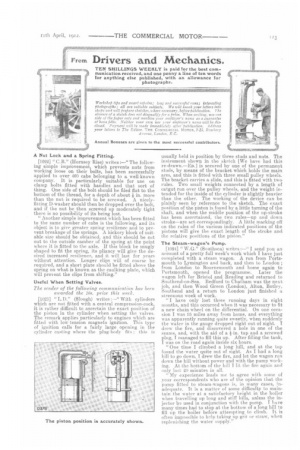From Drivers and Mechanics.
Page 21

If you've noticed an error in this article please click here to report it so we can fix it.
TEN SHILLINGS WEEKLY is paid For the best communication received, and one penny a line of ten words for anything else published, with an allowance for photographs.
A Nut Lock and a Spring Fitting.
[1022] " C.B." (Hornsey Rise) writes:—" The followMg simple improvement, which prevents nuts from working loose on their bolts, has been successfully applied to over 400 cabs belonging to a well known company. It is particularly suitable for use on clamp bolts fitted with handles and that sort of thing. One side of the bolt should be filed flat to the bottom of the thread, for a depth of about * in. more than the nut is required to be screwed. A nicelyfitting D-washer should then be dropped over the bolt., and if the nut be then screwed up moderately tight there is no possibility of its being lost.
"Another simple improvement which has been fitted to the same number of cabs is the following, and its object is to give greater spring resilience and to prevent breakage of the springs. A hickory block of suitable size should be obtained, and this should be cut out to the outside camber of the spring at the point where it is fitted to the axle. If this block be snugly shaped to fit the spring, its pliancy will give the desired increased resilience, and it will last. for years without attention. Longer clips will of course be required, and a short plate should be fitted above the spring on what is known as the caulking plate, which will prevent the clips from shifting."
Useful When Setting Valves.
The sender of the following communication has been awarded the 10s. prize this week.
[1023] "L.P." (Slough) writes With cylinders
which are not fitted with a central compression-cock, it is rather difficult to ascertain the exact position of the piston in the cylinder when setting the valves. The remark applies particularly to engines which are fitted with low-tension magneto ignition. This type of ignition calls. for a fairly large opening in the cylinder casting where the plug body fits ; this is
usually held in position by three studs and nuts. The instrument shown in the sketch [We have had thisre-drawn.—En.] is secured by one of the permanent studs, by means of the bracket which holds the main arm, and this is fitted with three small pulley wheels. The bracket carries a slide, and this is fitted with two rules. Two small weights connected by a length of catgut run over the pulley wheels, and the weight intended for the inside of the cylinder is slightly heavier than the other. The working of the device can be plainly seen by reference to the sketch. The exact position of the piston is found by a little turning of the shaft, and when the middle position of the up-stroke has been ascertained, the two rules—up and down stroke—are set correspondingly. A little marking off on the rules of the various indicated positions of the pistons will give the exact length of the stroke and the relative positions of the piston."
The Steam-wagon's Pump.
[lM] " W.G." (Southsea) writes:—" I send you an accountof a pretty full week's work which I have just completed with a steam wagon. A run from Portsmouth to Lymington and back, and then to London ; from London to Bournemouth and home again to Portsmouth, opened the programme. Later the wagon left for Bristol and Reading and returned to Southend-on-Sea. Bedford to Chatham was the next job, and then Wood Green (London), Alton, Botley, Southend and a return to London just finished a strenuous week of work.
"I have only lost three running days in eight months, and this occurred when it was necessary to fit a new chain-wheel on the differential. On one occasion I was 05 miles away from home, and everything. was apparently running quite sweetly, when suddenly the water in the gauge dropped right out of sight. I drew the fire, and discovered a hole in one of the seams, and, with the aid of a I-in, tap and a screwed plug, I managed to fill this up. After filling the tank,. I was on she road again inside six hours. "One time I climbed a long hill, and at the top found the water quite out of sight. As I had a long. hill to go down, I drew the fire, and let the wagon run down the hill without power and with the pump working. At the bottom of the hill I lit the fire again and only lost 20 minutes in all.
" My experience leads me to agree with some of your correspondents who are of the opinion that the pump fitted to steam-wagons is, in many cases, adequate. Tt is a matter of some difficulty to mainthin the water at a satisfactory height in the boiler when travelling up long and stiff hills, unless the injector be used in conjunction with the pump. I have many times had to stop at the bottom of a. long hill to fill up the boiler before attempting to climb. It is often impossible to hell) taking up grit or straw, when replenishing the water supply."






















